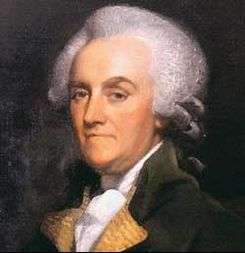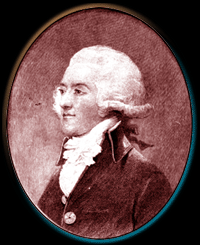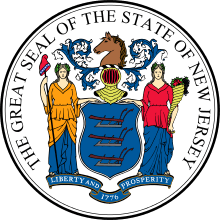William Franklin
| William Franklin | |
|---|---|
 | |
| 13th Colonial Governor of New Jersey | |
|
In office 1763–1776 | |
| Monarch | George III |
| Preceded by | Josiah Hardy |
| Succeeded by | |
| Personal details | |
| Born |
ca. 1730 Philadelphia |
| Died |
13/16/17 November, 1813 (aged 82–83) |
| Spouse(s) | Elizabeth Downes, Mary Johnson d'Evelin |
| Children | William Temple Franklin |
| Parents | Benjamin Franklin |
| Occupation | soldier, colonial administrator |
William Franklin FRSE (c.1730 – November 1813) was an American-born attorney, a colonial administrator, and the acknowledged illegitimate son of Benjamin Franklin. He was the last colonial Governor of New Jersey (1763–1776). Franklin was a steadfast Loyalist throughout the American Revolutionary War. As his father (Benjamin Franklin) was one of the most prominent Patriots and one of the Founding Fathers of the United States, their differences caused an irreconcilable break between them.
Following imprisonment during the war, in 1782 the younger Franklin went into exile in Britain. He lived in London until his death.
Early life
William Franklin was born in Philadelphia, Pennsylvania, then a colony in British America. He was the illegitimate son of Benjamin Franklin, a leading figure in the city. His mother's identity is unknown.[1] Confusion exists about William's birth and parentage because Benjamin was secretive about his son's origins. In 1750, Ben told his own mother that William was nineteen years old,[2] but this may have been an attempt to make the youth appear legitimate.
William was raised by Benjamin Franklin and Deborah Read, his common-law wife; William always called her his mother.[2] There is some speculation[3] that Deborah Read was William's mother, and that because of his parents' common-law relationship, the circumstances of his birth were obscured so as not to be politically harmful to him or to their marital arrangement.
William joined a company of Pennsylvania provincial troops in 1746 and fought in Albany in King George's War, obtaining the rank of captain in 1747.[4] As he grew older, he accompanied his father on several missions, including trips to England. Although often depicted as a young child when he assisted his father in the famed kite experiment of 1752, William was 21 years old at the time.
Marriage and family
As a young man, William became engaged to Elizabeth Graeme, daughter of prominent Philadelphia physician Dr. Thomas Graeme[5] and granddaughter of Pennsylvania's 14th Governor, Sir William Keith. Neither family approved of the match, but when William went to London to study law about 1759, he left with the understanding that Elizabeth would wait for him.

While in London, Franklin sired an illegitimate son, William Temple Franklin, who was born 22 February 1762. His mother has never been identified, and he was placed in foster care.[6]
Later that year, Franklin married Elizabeth Downes on 4 September 1762 at St George's, Hanover Square in London. She was born in the English colony of Barbados to the sugar planter John Downes and his wife Elizabeth (née Parsons). She met Franklin while visiting England with her father in 1760.[7] They moved to the New Jersey colony in 1763.
William Franklin's wife Elizabeth died in 1777 while he was imprisoned as a Loyalist during the American Revolutionary War. She was interred beneath the altar of St. Paul's Chapel in lower Manhattan, where she had resided after the British evacuated Perth Amboy. The memorial plaque on the wall at St. Paul's was commissioned by William Franklin from London, where he went into exile following the war.[7] He was a widower for more than ten years.
Career
William Franklin completed his law education in England, and was admitted to the bar. William and Benjamin Franklin became partners and confidantes, working together to pursue land grants in what was then called the Northwest (now Midwest). Before they left England, the senior Franklin lobbied hard to procure his son an appointment, especially working with the Prime Minister Lord Bute. William Franklin was appointed as Royal Governor of New Jersey.
In 1763, William Franklin was appointed as the Royal Governor of New Jersey, due to his father's influence with the British Prime Minister. He replaced Josiah Hardy, a merchant and colonial administrator. As governor, Franklin signed the charter for Queen's College, which would develop as Rutgers University in New Brunswick, New Jersey.
American Revolutionary War

Owing to his father's role as a Founding Father and William's loyalty to Britain, the relationship between father and son became strained past the breaking point. When Benjamin finally decided to take up the patriot cause, he tried to convince William to join him, but the son stayed loyal to the Crown.
William Franklin continued as governor until January 1776, when colonial militiamen placed him under house arrest, which lasted until the middle of June. After the Declaration of Independence on 4 July, Franklin was formally taken into custody by order of the Provincial Congress of New Jersey, an entity which he refused to recognize, regarding it as an "illegal assembly."[8] He was incarcerated in Connecticut for two years, in Wallingford and Middletown. He surreptitiously engaged Americans in supporting the Loyalist cause. Discovered, he was held in Litchfield, Connecticut for eight months. When finally released in a prisoner exchange in 1778, he moved to New York City, which was still occupied by the British.[9]
Active in the Loyalist community of New York, Franklin became President of the Board of Associated Loyalists. In 1779, he had learned through his friend, the poet Jonathan Odell, and British Secret Service chief Major John André, that Benedict Arnold was secretly defecting to the British.[10]
Asgill Affair
While in New York, Franklin tried to encourage a guerrilla war and active reprisals against the rebels but was frustrated by British Commander-in-Chief General Clinton, who did not support this. In 1782 Franklin was implicated in the Loyalist officer Richard Lippincott's hanging of Joshua Huddy. During a raid, Loyalist troops under Franklin's general oversight captured Joshua Huddy, an officer of the New Jersey militia. The Loyalist soldiers hanged Huddy in revenge for similar killings of Loyalists, particularly Phillip White. Huddy was a member of the Association of Retaliation, a vigilante body with a history of attacking and killing Loyalists and Neutrals in New Jersey.[11] At the time, some alleged that Franklin had sanctioned the killing of Huddy. This claim was theoretically substantiated by a note left on Huddy's body, which read, "Up goes Huddy for Philip White."
When he heard of Huddy's death, General George Washington threatened to execute Captain Charles Asgill, a British officer who had been captured at Yorktown, unless Lippincott were handed over to the American military. The British refused, but tried Lippincott. The British acquitted him of charges in the hanging. Due to the intervention of the French King Louis XVI, who interceded with his American allies to prevent Asgill's execution, the British officer was eventually exchanged by the Americans. Despite the speed with which it was terminated, the Asgill Affair temporarily stalled peace talks between American and British authorities-- extending uncertainty over the United States' prospects. Ironically, Benjamin Franklin was a senior negotiator for the revolutionary Americans in Paris when the Asgill Afair occurred.
Exile
In 1782, William Franklin departed for Britain, never to return. In London, he became a leading spokesman for the Loyalist community. Because of the continued strength of British forces in North America, in spite of the disaster at Yorktown, many expected Britain to continue fighting the war. The British naval victory against the French at the Battle of the Saintes and the successful defence of Gibraltar also raised their hopes. In summer 1782 a new British government came to power, who still hoped to achieve a reconciliation with the American colonies.
In 1783 he visited Scotland and was asked to be a founding member of the Royal Society of Edinburgh.[12]
Benjamin Franklin dedicated his autobiography (written before the war) to his son,[13] though the only mention of William within the manuscript is the inclusion of a newspaper article in which Franklin noted that his son was authorized to make contracts to purchase carts for the British army.[14] But Ben and his son were never reconciled; the elder Franklin became known for his uncompromising position related to not providing compensation nor amnesty for the Loyalists who left the colonies, during the negotiations in Paris for the Peace of Paris. His son's reputation as a Loyalist may have contributed to his position.
William Franklin sent a letter to his father, dated 22 July 1784, in an attempt at reconciliation. His father never accepted his position, but responded in a letter dated 16 August 1784, in which he states "[We] will endeavor, as you propose mutually to forget what has happened relating to it, as well we can."[15] William saw his father one last time in 1785, when Benjamin stopped in Britain on his return journey to the United States after his time in France. The meeting was brief and involved tying up outstanding legal matters. In a reconciliation attempt, Benjamin also proposed that his son give land that he owned in New York and New Jersey to William's son Temple, who had served as Ben's secretary during the war and for whom the elder Franklin had great affection, in order to repay a debt William owed his father; in the event, William only ever transferred the New York portion of the land.[16] In his 1788 will, Benjamin left William virtually none of his wealth, except some territory in Nova Scotia and some property already in William's possession. He said that had Britain won the war, he would have had no wealth to leave his son.[17]
On 14 August 1788, the widower William married Mary Johnson d'Evelin, a widow with children, as his second wife. Temple, after a failed business career in the United States, lived with them for a time, fathering an illegitimate daughter, Ellen (1798–1875), by a daughter of his stepmother Mary.[6] Temple moved to Paris, where he lived the remainder of his life. William died in 1813, and is buried in St Pancras Old Church churchyard. The grave is lost.
Legacy and honors
- Franklin Township in Bergen County, New Jersey, was named in William's honor, as was the borough of Franklin Lakes.
See also
Notes
- ↑ New Jersey Department of State gives 13 Nov., Encyclopedia.com gives 16 Nov. and Geni.com gives 17 Nov.
References
- ↑ "Franklin, Benjamin", Britannica Online, retrieved 16 November 2006
- 1 2 Randall 1984, p. 43.
- ↑ Hart 1911.
- ↑ Skemp 1990, p. 10.
- ↑ "Thomas Græme", ushistory.org, archived from the original on 12 June 2011
- 1 2 Franklin, William Temple, Papers, 1775–1819, American Philosophical Society, archived from the original on 7 May 2009, retrieved 4 November 2012
- 1 2 Burstyn, Joan N (1997), Past and Promise: Lives of New Jersey Women, Syracuse Univ Pr, pp. 20–21, ISBN 0-8156-0418-1.
- ↑ Skemp 1990, p. 211.
- ↑ William Franklin, Info please.
- ↑ Randall, Willard Sterne (1990). Benedict Arnold: Patriot and Traitor. William Morrow and. pp. 457–59. ISBN 1-55710-034-9.
- ↑ Fleming, pp. 188–89.
- ↑ Biographical Index of Former Fellows of The Royal Society of Edinburgh 1783 – 2002 (PDF). Royal Society of Edinburgh. July 2006. p. 330. ISBN 0 902 198 84 X.
- ↑ Franklin, Benjamin, "Dedication", Autobiography,
Dear Son:...
- ↑ Franklin, Benjamin, Benjamin Franklin, his autobiography, The Harvard classics. 1909–14, New York: P.F. Collier & Son, retrieved 5 July 2006 – via bartleby.com.
- ↑ Franklin, Benjamin, Autobiography, Poor Richard, and Later Writings, Library of America, pp. 356–58.
- ↑ Asmar, Melanie (May 2016). "Ben Franklins family quarrel". Yale Alumni Magazine. Retrieved 2016-09-14.
- ↑ Franklin, Benjamin, Last Will and Testament, FI, retrieved 5 July 2006.
Bibliography
- Ford, Paul Leicester (1889), Who Was the Mother of Franklin's Son?: An Historical Conundrum, Hitherto given up—Now Partly Answered, Brooklyn.
- Hart, Charles Henry (1911), "Who Was the Mother of Franklin's Son: An Inquiry demonstrating that she was Deborah Read, wife of Benjamin Franklin", Pennsylvania Magazine of History and Biography, PSU, 35 (3): 308–14.
- Randall, Willard Sterne (1984), A Little Revenge: Benjamin Franklin & His Son, Little, Brown & Co.
- Skemp, Sheila (1990), William Franklin: Son of a Patriot, Servant of a King, Oxford University Press.
External links
- Biography of William Franklin, Book rags
- Biography of William Franklin, Franklin Institute, archived from the original on 3 July 2007
- William Franklin at Find a Grave
- The Proprietary House (final home of the Royal Governor)
| Government offices | ||
|---|---|---|
| Preceded by Josiah Hardy |
Governor of New Jersey Last Colonial Governor 1763–1776 Last Royal Governor |
Succeeded by William Livingston First Revolutionary Governor |
